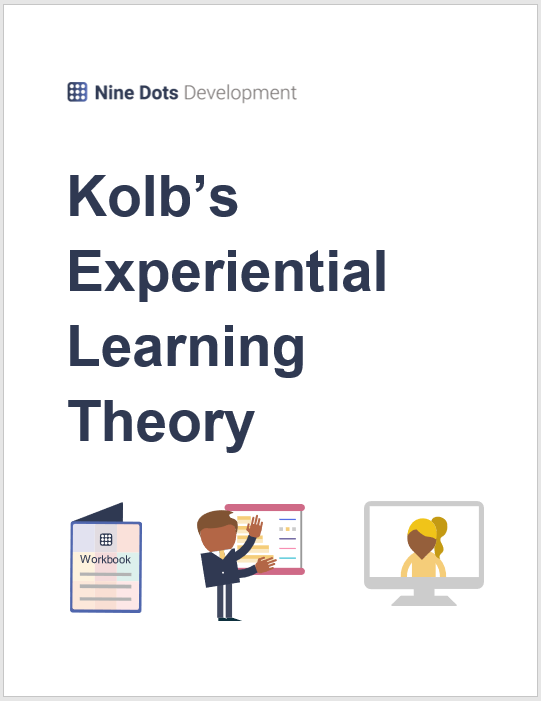Thursday 10 Jun 2021 Article
The TakeawayKolb’s Experiential Learning Theory
Understanding Different Learning Styles and Their Implications on Your Organisation’s L&D Approach
Part 1 of 4
#L&DStrategy #LearningStyles #ExperientialLearningTheory #PersonalDevelopment
The perfectly matched resource for this article...
Download Our 'Kolbs Experiential Learning Theory' Diagram!
Please click below to download our 'Kolbs Experiential Learning Theory' diagram!
Download diagram!Playing catchup?
Kolb’s Experiential Learning Theory
We all have different approaches to learning and different styles that work best for us.
It can be extremely difficult to develop your staff in the most efficient way possible if you don’t understand the learning cycle and different learning styles.
So how can you use Kolb’s Experiential Learning Theory to improve your L&D approach?
What is Kolb’s Experiential Learning Theory?
David Kolb created his Experiential Learning Theory in 1984.
Kolb’s Experiential Learning Theory has two parts – The Experiential Learning Cycle and 4 Learning Styles.
The main idea behind Kolb’s Learning Theory is that “learning is the process whereby knowledge is created through the transformation of experience”.
Put simply, we learn from the things we experience.
What is Kolb’s Experiential Learning Cycle?
Kolb’s Experiential Learning Cycle is a 4-part process which Kolb claimed to be the cycle of ‘effective learning’.
It is an integrated process, meaning that each stage is connected and follows on from the previous stages.
Kolb’s Experiential Learning Cycle consists of:
- Concrete Experience
The first stage is the experience itself. For example, the experience could be observing something happening in the workplace. - Reflective Observation
Next, we process and review/reflect on the experience. - Abstract Conceptualisation
Then, we think about what we have concluded or learned from the experience. - Active Experimentation
Finally, we put the learning into practice.
Kolb’s theory states that in order for learning to be ‘effective’, learners must go through every stage in the Experiential Learning Cycle which is why it’s so crucial that L&D staff understand and implement it.
What Are Kolb’s 4 Learning Styles?
Different people naturally have different preferred learning styles.
Our preferences can be influenced by many different things, including social environment, educational experiences, or our basic cognitive structures.
Kolb identified four learning styles:
- Diverging
People with a diverging learning style are able to look at things from different perspectives, making them great problem solvers. These people think outside-the-box and are extremely creative so they work best in situations that require innovation and idea-generation. They also tend to prefer working in groups and like giving and receiving feedback. - Assimilating
On the other hand, people with an assimilating learning style usually prefer logical, systematic tasks and they excel in understanding a wide range of information and organising it in a clear format. These people tend to enjoy formal learning opportunities such as readings and lectures that explore analytical models and prefer being given clear direction and instructions rather than practical opportunities when doing something new. - Converging
Having a converging learning style means preferring technical tasks over interpersonal aspects of work. People with this learning style often enjoy problem-solving and experimenting with new ideas, making them great at implementing and finding practical uses for ideas and theories. - Accommodating
The accommodating learning style is the most common of Kolb’s 4 Learning Styles and involves a hands-on, practical, experiential approach. People with an accommodating learning style often rely on intuition rather than logic and usually act on gut instinct rather than analytical information. They enjoy new challenges and, more often than not, embrace change instead of resisting it.
Implications of Kolb’s Experiential Learning Theory on Your Organisation’s L&D Approach
There are many things you can take away from Kolb’s Experiential Learning Theory, but these are the three main points we highly recommend considering:
- Reflect on your existing staff development strategy and make sure it covers every stage of Kolb’s Experiential Learning Cycle.
- Look into new training opportunities to ensure that you have options to cater for all 4 learning styles.
- Utilise your staff’s preferred learning styles as much as possible but also try to strengthen them in their less preferred styles.
Understanding the Experiential Learning Cycle and different learning styles will help you develop your staff to their full potential.
If you’d prefer a visual representation of Kolb’s Learning Cycle, you can download our free Learning Cycle Diagram PDF by clicking the link below.
---
Tomorrow we will be exploring the 70:20:10 Model of Learning and Development and how it can help you build a high performance learning culture, so stay tuned!
Download Our 'Kolbs Experiential Learning Theory' Diagram!
Please click below to download our 'Kolbs Experiential Learning Theory' diagram!
Download diagram!Missed an article?
More from Understanding Different Learning Styles and Their Implications on Your Organisation’s L&D Approach
